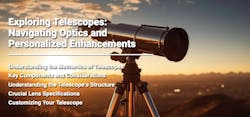Exploring Telescopes: Navigating Optics and Personalized Enhancements
Telescopes, functioning on the principle of angular magnification, provide a means for observing distant objects by expanding their angular fields. The construction of telescopes, despite its apparent complexity, is grounded in a straightforward concept, allowing for various customization options.
Understanding the Mechanics of Telescopes
Telescopes, essential tools for astronomers exploring the cosmos, predominantly utilize curved mirrors to collect and focus light from the night sky. While early telescopes employed lenses made of curved glass, contemporary models opt for mirrors due to their lighter weight and the ease of achieving a smooth surface.
The effectiveness of a telescope’s optics, whether mirrors or lenses, hinges on their near-flawless quality to efficiently concentrate light. Larger optics enhance a telescope’s light-gathering capacity, resulting in clearer images. The choice between refractors and reflectors is based on design practicality, with reflectors often favored in modern observatories for their size.
Key Components and Considerations
The objective lens, closest to the observed object, collaborates with the eyepiece to form an image. Focal length plays a crucial role in determining magnifying power, where a longer focal length allows for higher magnification. However, longer focal lengths can compromise portability, a factor to consider when selecting a telescope.
The mantra “aperture is king” underscores the significance of a telescope’s aperture size. Larger apertures facilitate increased light gathering, resulting in brighter and clearer images. While a larger aperture is advantageous, it brings along portability challenges, emphasizing the need for a careful examination of both focal length and aperture size.
Understanding the Telescope’s Structure
A refractor comprises a long tube housing lenses, with the objective lens at the front and the eyepiece in a secondary tube. Adjusting the eyepiece lenses focuses the image, while a classical Newtonian reflector features an objective mirror at the tube’s end, a secondary mirror at a 45-degree angle, and an eyepiece on the side.
Reflecting telescopes, utilizing mirrors, offer advantages such as reduced weight, easier cleaning, and polishing. However, they invert images, necessitating additional mirrors for correction.
Crucial Lens Specifications
Telescope lenses come with vital specifications:
- Aperture Diameter: Determines light-gathering capability.
- Focal Length: Influences magnification and field of view.
- F/number: Impacts speed and low-light performance.
Customizing Your Telescope
Customization options include selecting the right lens type, eyepieces for varied magnifications, Barlow lenses for increased magnification, filters for enhanced views, collimation tools for alignment, and astrophotography accessories for improved image quality.
Elevate your telescope’s performance by upgrading optics with professional expertise. Shanghai Optics, a leading custom optics company, offers skilled telescope technicians with specialized knowledge. Their assistance ensures seamless integration of upgraded optics, encompassing precise adjustments, fine-tuning of focal lengths, and incorporation of specialized optical components for an optimized telescope system.
Do not hesitate to contact Shanghai Optics today. We’d be more than happy to discuss your projects and how best they can become a success.
